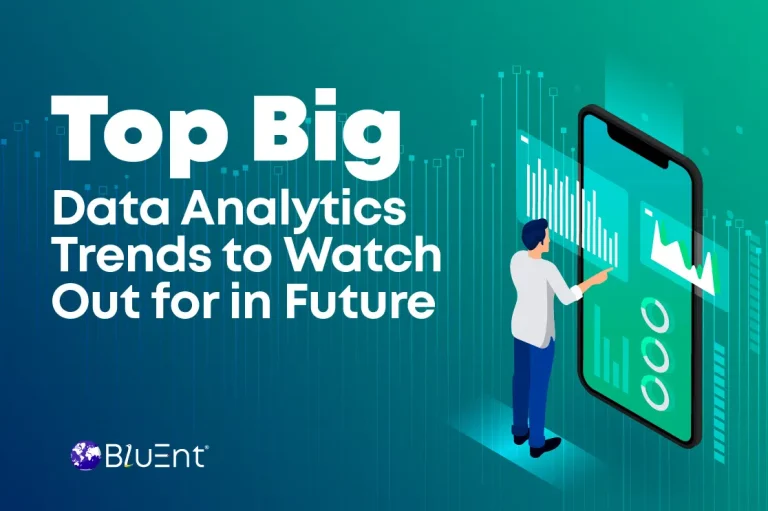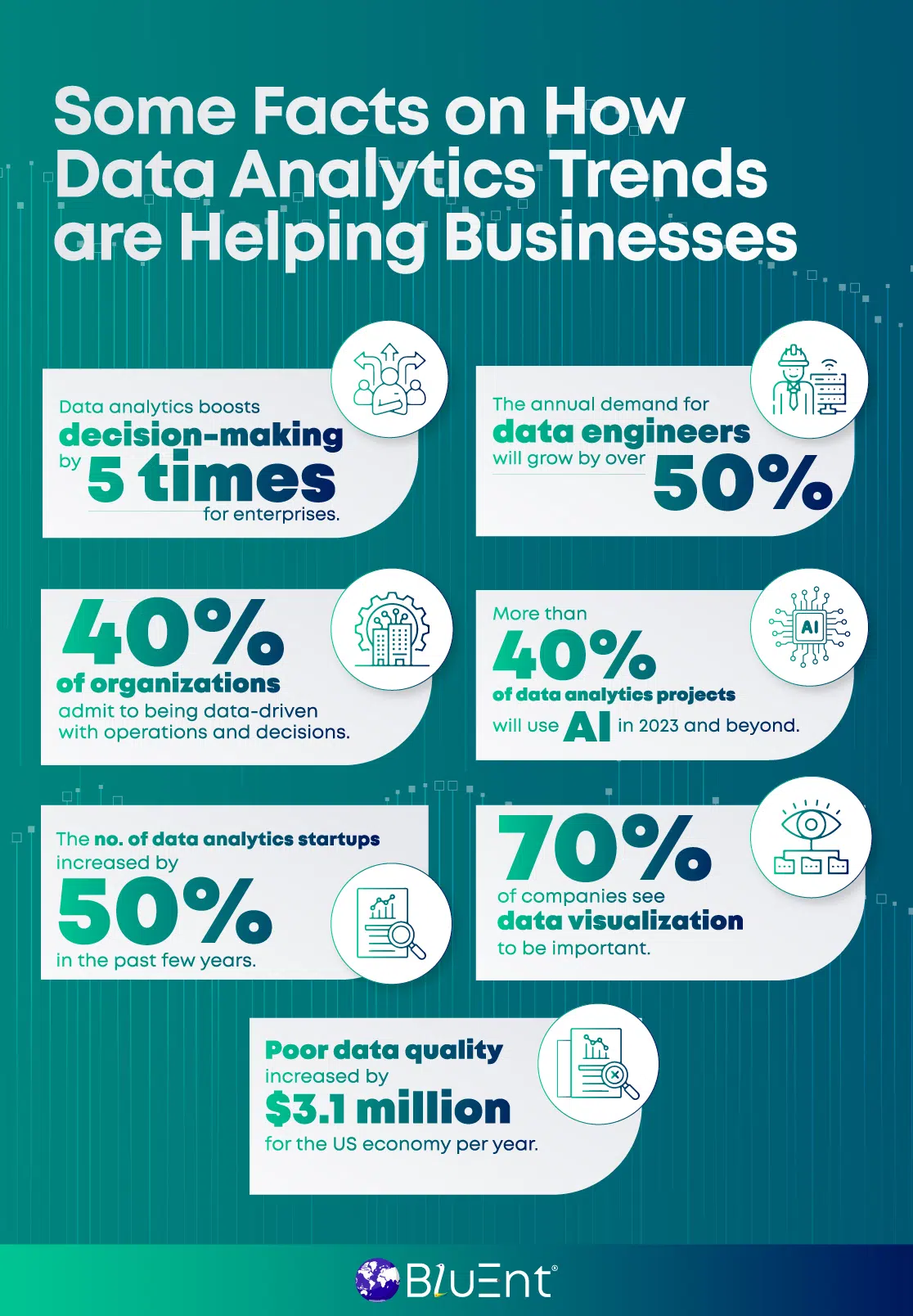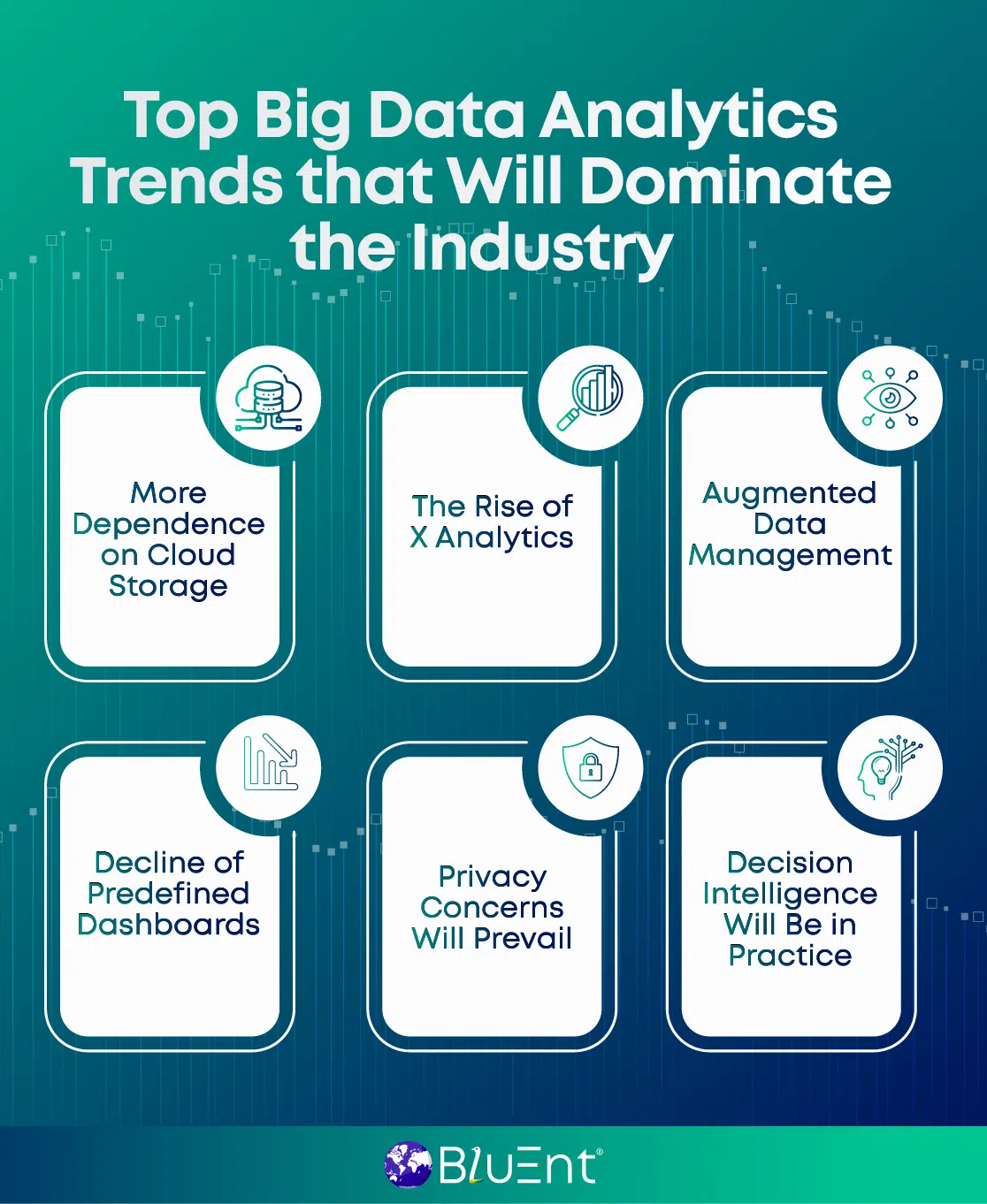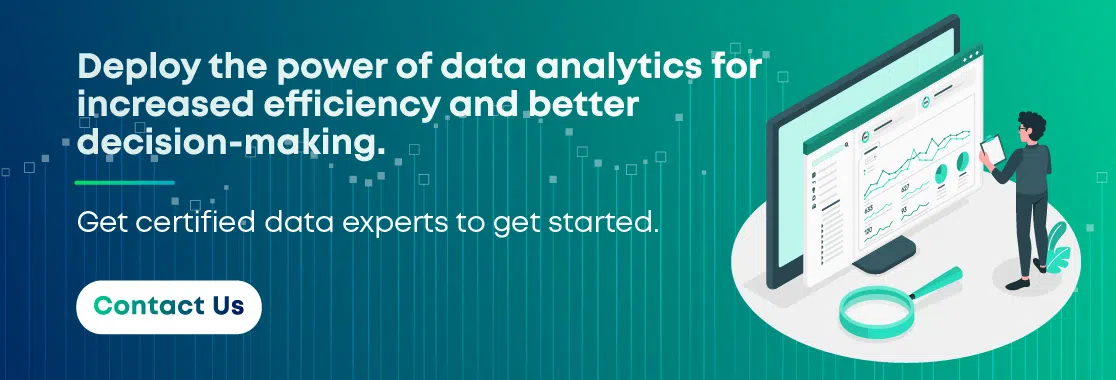Businesses are paying extra attention to big data analytics trends to stay ahead of the competition.
Everyone from healthcare to top tech companies uses big data analytics to grow profits. It contributes to real-time location tracking, precision medicine, fraud detection, sales and marketing, employee analytics, and other areas.
As per Statista, the global data analytics market is worth $274 billion and is projected to reach $655 bn by 2029.
What’s driving this kind of explosive growth? And what will be the significant big data trends businesses must keep their eyes on?
Let’s get familiar with them one by one.
Table of Contents:
What Is Big Data Analytics?
Before you understand the data analytics industry trends, you must get a brief on big data analytics. (No, it’s not the same thing as business analytics.)
There are as many definitions of big data analytics as small businesses. We’ll take that information and break it down for you.
We must first understand what big data means to define big data analytics.
The Definition of Big Data
The significance of big data can’t be explained without learning about relational databases.
A relational database is a collection of data items that have pre-defined relationships and are organized into a table structure. This model made data more easily accessible as only people with advanced programming skills could manage their data before it existed.
The benefits of relational databases include consistency, atomicity and commitment, stored procedures, concurrency, and more.
However, as helpful as this model is, it cannot handle data beyond a specific size. That’s where enterprise big data management steps in.
Unlike relational databases, it uniquely suits today’s stupefying data.
As the name suggests, big data characteristics include wide variety, volume, and velocity.
Big data, hence, refers to vast sets of data.
Big data analytics decodes this data and delivers business insights, thus helping organizations make profitable decisions. Some common types of data analytics and techniques include data mining, machine learning, predictive analytics, and AI.
Top Big Data Analytics Trends to Keep an Eye On
The explosion of data analytics is driven primarily by the benefits it serves, such as faster innovation cycles, productive research and development, and improved business efficiencies.
Companies investing in big data analytics are planning to use it for:
-
Social media and sales analytics (50%)
-
Documents & texts (44%)
-
Clickstream media (41%)
-
Videos & images (34%)
-
Machine data (29%)
-
Transaction data (28%)
-
System logs (25%)
Organizations plan to monetize their data via the provision of digital platforms (38%), analysis results (26%), and data via benchmarking (25%).
Now, let’s go through significant big data trends your business should focus on today and in the future.
More Dependence on Cloud Storage
Cloud computing needs no introduction to the modern world of tech-driven enterprises. Most business strategists and analysts use custom cloud data analytics solutions to manage both structured and unstructured data on the cloud.
Multi-cloud information tech strategies will help businesses better manage their data and keep it accessible. Hence, more dependence on the cloud is one of the significant data analytics trends you must focus on right now.
The Rise of X Analytics
Gartner created the term ‘X analytics.’ It is an umbrella term where X is the data variable for various content (structured and unstructured), such as video analytics and text analytics.
This method will tackle some of humanity’s most complex challenges, like disease prevention and global warming. Companies using predictive analytics for risk management take advantage of X analytics to forecast uncertainty.
Augmented Data Management
Another big data trend outlines the role of artificial intelligence and machine learning algorithms in big data management.
That uses advanced AI software or tools like ChatGPT for business data analytics to optimize operations and performance. It also contributes to security, fraud detection, and management.
Decline of Pre-defined Dashboards
Visual exploration and authoring will be succeeded by dynamic data stories with custom, tailored, and automated experiences.
That indicates the end of pre-defined dashboards only viable for technical teams or professionals with specific skills. The latest big data analytics industry trends highlight the increasing adoption of flexible and interactive dashboards for data reporting, analysis, and visualization.
Privacy Concerns Will Prevail
Security issues will not go away any time soon. That’s also a significant concern for big data analytics service providers.
Data volumes will continue to rise, creating further challenges in shielding it from cyber-attacks and other intrusions. That is because the levels of data protection need to catch up with the increase in the rate of data.
Companies must leverage fraud data analytics to protect their business from privacy risks and other vulnerabilities.
Decision Intelligence Will Be in Practice
That will include amalgamating various categories, such as decision support and management. It will aid data analysts in monitoring, executing, and designing decision models.
Recommended Reading:
Process of Implementing Big Data Analytics Trends
When there is such a vast amount of raw data, it needs to be processed in a certain way to acquire insights.
That can be broken down into four steps:
Ingestion > Storage > Analysis > Consumption
Depending on factors such as the amount of data, ease of accessibility, and the objective, big data projects can take anywhere between a week to six months. That is how enterprises can use big data analytics trends in their database maintenance strategy.
Check out our featured case studies on big data analytics and discover how it works.
How Can Businesses Use Big Data Analytics Industry Trends in the Future?
Big data and business analytics trends can benefit any organization.
The top 5 sectors that could benefit the most from big data analytics services are:
-
Banking & securities
-
Healthcare
-
Media and communications
-
Gaming
-
Education
-
Manufacturing.
That’s all well and good. But what, you ask, about the charming little family-owned business you frequent down the street? How could they profit from data analytics services?
You may have heard the term ‘Big data for small businesses.’ Such businesses can benefit from reduced costs, improved pricing, and increased revenue.
Many of the most successful companies around the globe are investing heavily in big data and predictive analytics. Over 90% of Fortune 1000 companies are increasing investments in big data.
However, companies need expert assistance to use data trends to streamline processes and gain more profits than competitors.
Why Is BluEnt the Right Partner for Big Data Analytics Solutions and Consulting?
Big data is an immense fortune for businesses aiming to streamline their workflow and improve decision-making. However, it will give rise to obstacles in the future, such as difficulties in data processing and storage, security risks, and even a shortage of data professionals.
Regardless of that, the benefits of big data outweigh the challenges. The value added from big data analytics will be immense. Many companies will go from generating data to being powered by data.
If you’ve read till here, you’re driven to gain an edge by diving into data analytics. BluEnt’s big data analytics services are at your fingertips. Our complete enterprise data management services include big data management, big data analytics and insights, predictive analytics, and big data implementation.
With our dedicated and certified experts, your business can make decisions that lead to greater profits and faster decision-making.
Ready to get ahead of your competitors with data analytics services? Contact us now.
Frequently Asked Questions
What’s the role of artificial intelligence in big data analytics?
Advanced AI and machine learning tools add value to decision-making and predictive analytics.
They collaborate with modern business intelligence solutions to automate ETL (Extract, Transform, and Load) processes for streamlined data visualization and analysis.
How do you stay updated with data analytics industry trends?
Companies that are using data analytics already or either planning for it can keep up with the latest trends with these tips:
-
Go through industry publications and reports
-
Attend conferences and workshops
-
Follow data analytics thought leaders
-
Join online training programs and courses
















 Snowflake Cortex Agents: Scalable AI for Enterprise Data Insights
Snowflake Cortex Agents: Scalable AI for Enterprise Data Insights  Informatica ETL vs Informatica MDM: Which One Does Your Business Need?
Informatica ETL vs Informatica MDM: Which One Does Your Business Need?  How Financial and Accounting Services by BluEnt Drive Business Growth in the Digital Era?
How Financial and Accounting Services by BluEnt Drive Business Growth in the Digital Era?  Secure Gift Cards: Top Tips and Strategies’ to Safeguard Personal Information
Secure Gift Cards: Top Tips and Strategies’ to Safeguard Personal Information 
